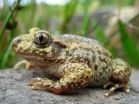(Press-News.org) Inadequate knowledge about the effects of deepwater oil well blowouts such as the Deepwater Horizon event of 2010 threatens scientists' ability to help manage and assess comparable events in future, according to an article that a multi-author group of specialists will publish in the May issue of BioScience. Even federal "rapid response" grants awarded to study the Deepwater Horizon event were far more focused on near-surface effects than on the deepwater processes that the BioScience authors judge to be most in need of more research.
The article, by a team led by Charles H. Peterson of the University of North Carolina, argues that a fundamentally new approach to the study of deepwater oil spills is needed. Previous research has focused mainly on effects on organisms found near the sea surface and on coasts. The new approach would also stress how oil and associated gas released at depth move through the sea and affect subsurface and bottom-dwelling organisms. The new approach is all the more important because the oil industry is now putting most of its exploration efforts into deep water.
Peterson and his colleagues point out that existing policies and legislation have notably failed to provide for research initiated promptly after a spill has been detected. This has prevented studies that might have guided emergency response procedures two years ago, in particular studies of the effects of chemical dispersants. These were used extensively while the Deepwater Horizon spill was in progress, although there is little consensus on their effectiveness.
There remain "serious gaps" in background information needed for longer-term assessments of comparable spills, according to Peterson and his coauthors. Much more information is needed about deep-sea ecology and the processes by which oil released at depth is degraded by microbes, for example. The gaps impede not only litigation and improvement of government policy, but also attempts to restore damaged ecosystems
###
BioScience, published monthly, is the journal of the American Institute of Biological Sciences (AIBS; www.aibs.org). BioScience is a forum for integrating the life sciences that publishes commentary and peer-reviewed articles. The journal has been published since 1964. AIBS is a meta-level organization for professional scientific societies and organizations that are involved with biology. It represents nearly 160 member societies and organizations. The article by Peterson and colleagues is available for the remainder of April online ahead of print at www.aibs.org/bioscience-press-releases/
The complete list of peer-reviewed articles in the May 2012 issue of BioScience is as follows.
A Tale of Two Spills: Novel Science and Policy Implications of an Emerging New Oil Spill Model.
Charles H. Peterson, Sean S. Anderson, Gary N. Cherr, Richard F.
Ambrose, Shelly Anghera, Steven Bay, Michael Blum, Robert Condon,
Thomas A. Dean, Monty Graham, Michael Guzy, Stephanie Hampton,
Samantha Joye, John Lambrinos, Bruce Mate, Douglas Meffert,
Sean P. Powers, Ponisseril Somasundaran, Robert B. Spies, Caz M.
Taylor, Ronald Tjeerdema, and E. Eric Adams
Rethinking the Origin of Chronic Diseases.
Mohammadali M. Shoja, R. Shane Tubbs, Alireza Ghaffari,
Marios Loukas, and Paul S. Agutter
Prospects for Sustainable Logging in Tropical Forest.
Barbara L. Zimmerman and Cyril F. Kormos
Energy and Matter: Differences in Discourse in Physical and
Biological Sciences Can Be Confusing for Introductory Biology
Students.
Laurel M. Hartley, Jennifer Momsen, April Maskiewicz, and
Charlene D'Avanzo
Studying Biodiversity: Is a New Paradigm Really Needed?
James D. Nichols, Evan Cooch, Jonathan M. Nichols, and
John R. Sauer
Finding Common Ground for Biodiversity and Ecosystem Services.
Belinda Reyers, Stephen Polasky, Heather Tallis, Harold A. Mooney,
and Anne Larigauderie
Why Ecosystem-Based Management May Fail without Changes to Tool Development and Financing.
Corrie Curtice, Daniel C. Dunn, Jason J. Roberts, Sarah D. Carr, and Patrick N. Halpin
END
A new University of British Columbia study finds that the way individuals experience the universal emotion of pride directly impacts how racist and homophobic their attitudes toward other people are.
The study, published in the April issue of Personality and Social Psychology Bulletin, offers new inroads in the fight against harmful prejudices such as racism and homophobia, and sheds important new light on human psychology.
"These studies show that how we feel about ourselves directly influences how we feel about people who are different from us," says Claire Ashton-James, ...
PASADENA, Calif.—What happens to a stem cell at the molecular level that causes it to become one type of cell rather than another? At what point is it committed to that cell fate, and how does it become committed? The answers to these questions have been largely unknown. But now, in studies that mark a major step forward in our understanding of stem cells' fates, a team of researchers from the California Institute of Technology (Caltech) has traced the stepwise developmental process that ensures certain stem cells will become T cells—cells of the immune system that help ...
San Francisco, April 12, 2012 -- Scientists will convene in San Diego to present the latest seismological research at the annual conference of the Seismological Society of America (SSA), April 17-19.
This year's meeting is expected to draw a record number of registrants, with more than 630 scientists in attendance, and will feature 292 oral presentations and 239 poster presentations.
"For over 100 years the Annual Meeting of SSA has been the forum of excellence for presenting and discussing exciting new developments in seismology research and operations in the U.S. ...
The roads are the main cause of fragmenting the habitats of many species, especially amphibians, as they cause them to be run over and a loss of genetic diversity. Furthermore, traffic harms two abundant species that represent the amphibious Asturian fauna and have been declared vulnerable in Spain: the midwife toad (Alytes obstetricans) and the palmate newt (Lissotriton helveticus).
"But midwife toad and palmate newt populations have very different sensitivities to the effects of roads" Claudia García-González, researcher at the University of Oviedo, told SINC. "These ...
In order to survive, plants should take up neither too many nor too few minerals from the soil. New insights into how they operate this critical balance have now been published by biologists at the Ruhr-Universität in a series of three papers in the journal The Plant Cell. The researchers discovered novel functions of the metal-binding molecule nicotianamine. "The results are important for sustainable agriculture and also for people – to prevent health problems caused by deficiencies of vital nutrients in our diet" says Prof. Dr. Ute Krämer of the RUB Department of Plant ...
Astronomers using ESA's Herschel Space Observatory have studied a ring of dust around the nearby star Fomalhaut and have deduced that it is created by the collision of thousands of comets every day.
Fomalhaut, a star twice as massive as our Sun and around 25 light years away, has been of keen interest to astronomers for many years. With an age of only a few hundred million years it is a fairly young star, and in the 1980s was shown to be surrounded by relatively large amounts of dust by the IRAS infrared satellite. Now Herschel, with its unprecedented resolution, has ...
Researchers at the University of Liverpool have resolved the debate over the mechanisms involved in the shut-down process during cell division in the body.
Research findings, published in the journal PNAS, may contribute to future studies on how scientists could manipulate this shut-down process to ensure that viruses and other pathogens do not enter the cells of the body and cause harm.
Previous research has shown that when cells divide, they cannot perform any other task apart from this one. They cannot, for example, take in food and fluids at the same time as ...
Our obsession with multiple forms of media is not necessarily all bad news, according to a new study by Kelvin Lui and Alan Wong from The Chinese University of Hong Kong. Their work shows that those who frequently use different types of media at the same time appear to be better at integrating information from multiple senses - vision and hearing in this instance - when asked to perform a specific task. This may be due to their experience of spreading their attention to different sources of information while media multitasking. Their study is published online in Springer's ...
Researchers at the Hospital de Mar Research Institute (IMIM) have discovered that the protein LOXL2 has a function within the cell nucleus thus far unknown. They have also described a new chemical reaction of this protein on histone H3 that would be involved in gene silencing, one of which would be involved in the progression of breast, larynx, lung and skin tumours.
Led by Dr Sandra Peiró and published in Molecular Cell journal, the study is a significant advance in describing the evolution of tumours and opens the door to researching new treatments that block their ...
About 300 000 years ago humans adapted genetically to be able to produce larger amounts of Omega-3 and Omega-6 fatty acids. This adaptation may have been crucial to the development of the unique brain capacity in modern humans. In today's life situation, this genetic adaptation contributes instead to a higher risk of developing disorders like cardiovascular disease.
The human nervous system and brain contain large amounts of polyunsaturated fatty acids, and these are essential for the development and function of the brain. These Omega-3 and Omega-6 fatty acids occur ...



